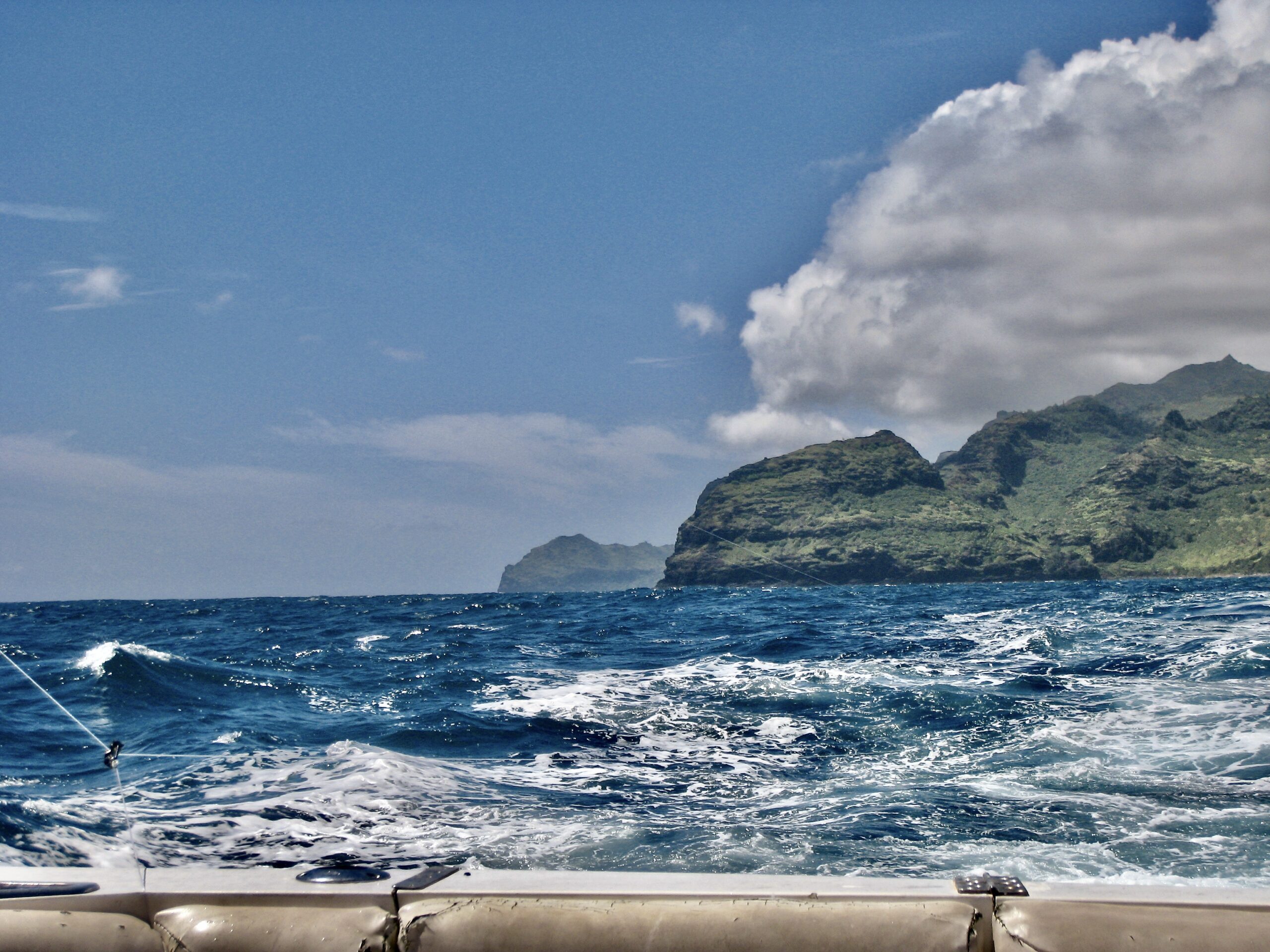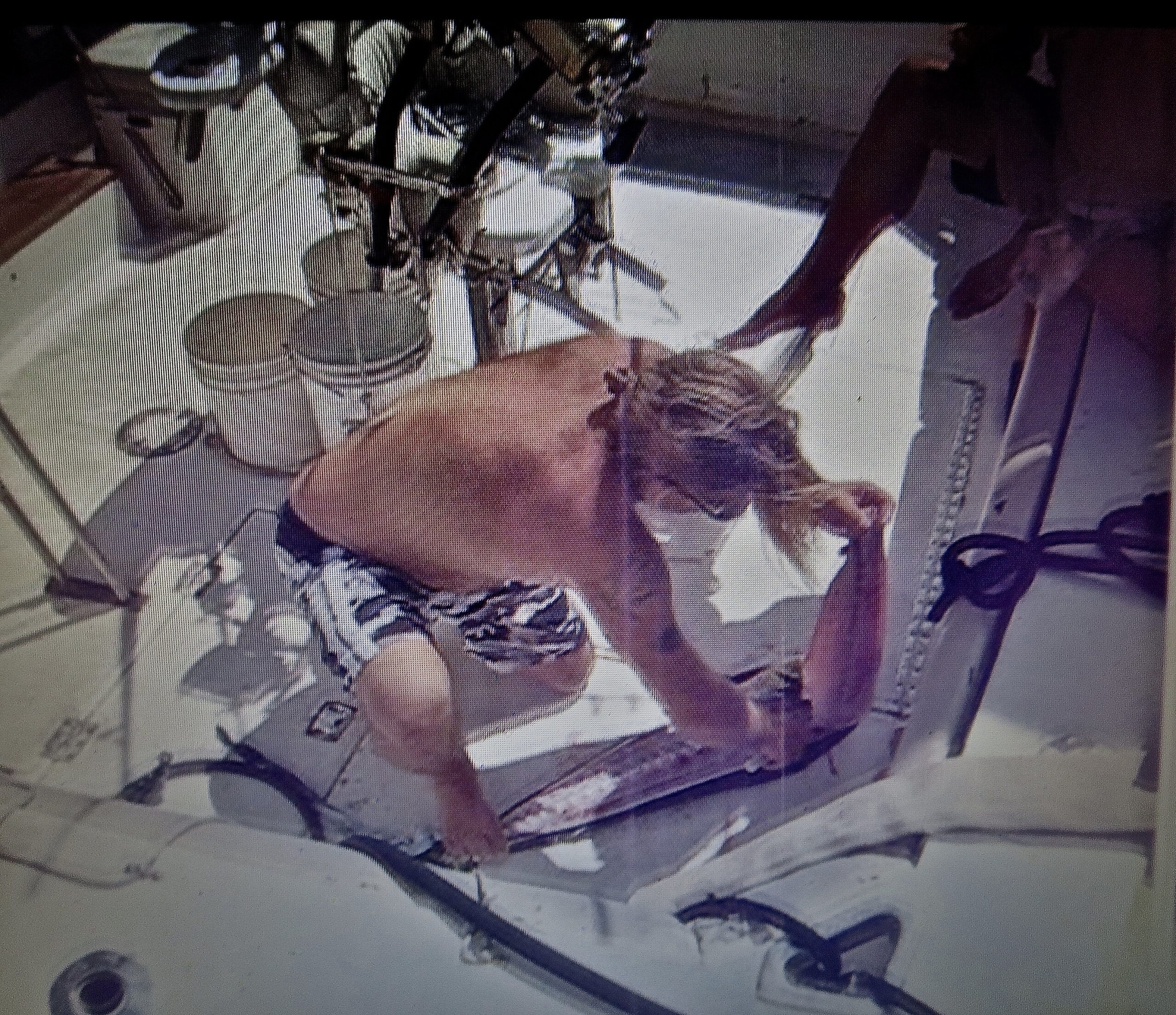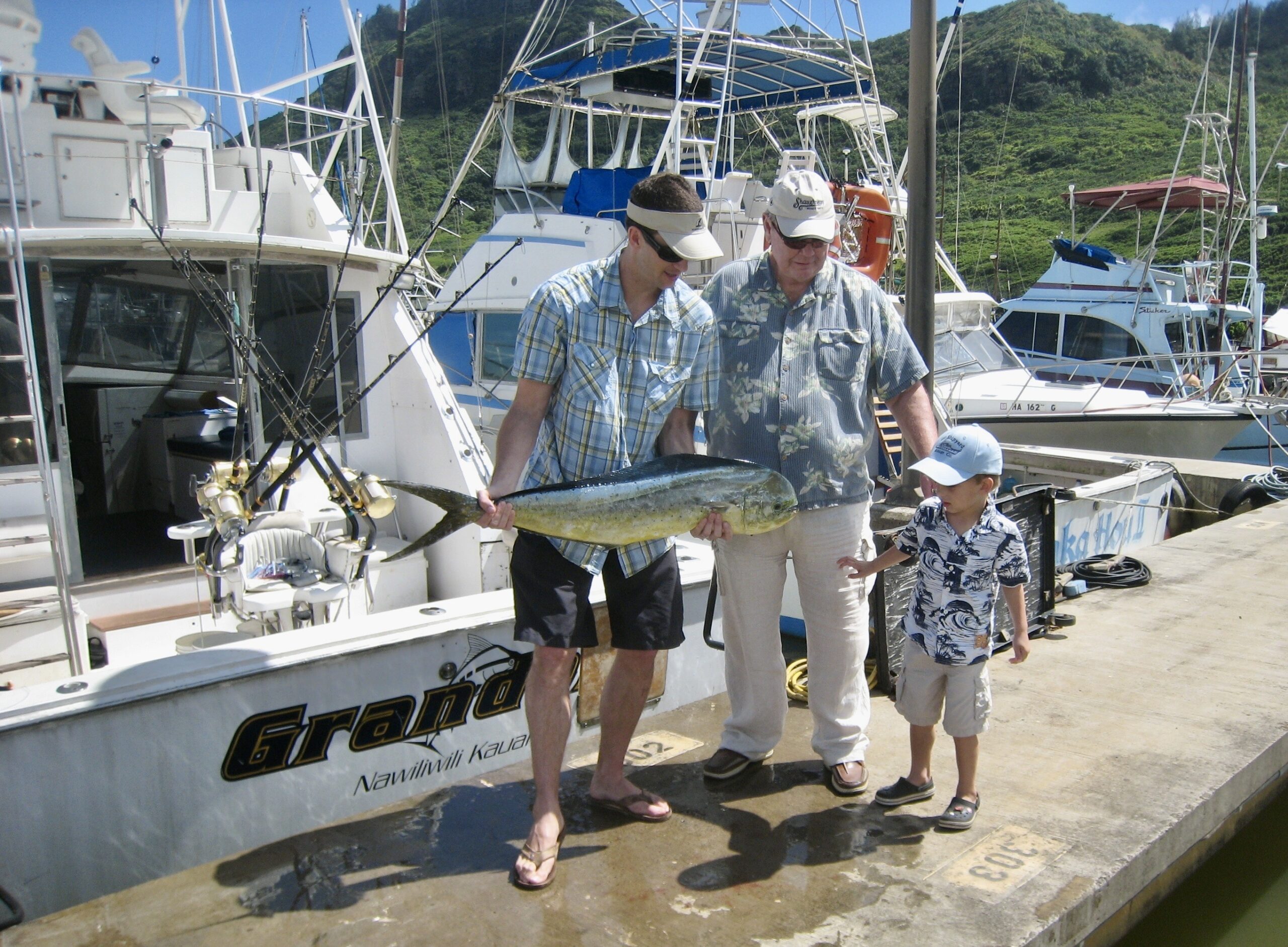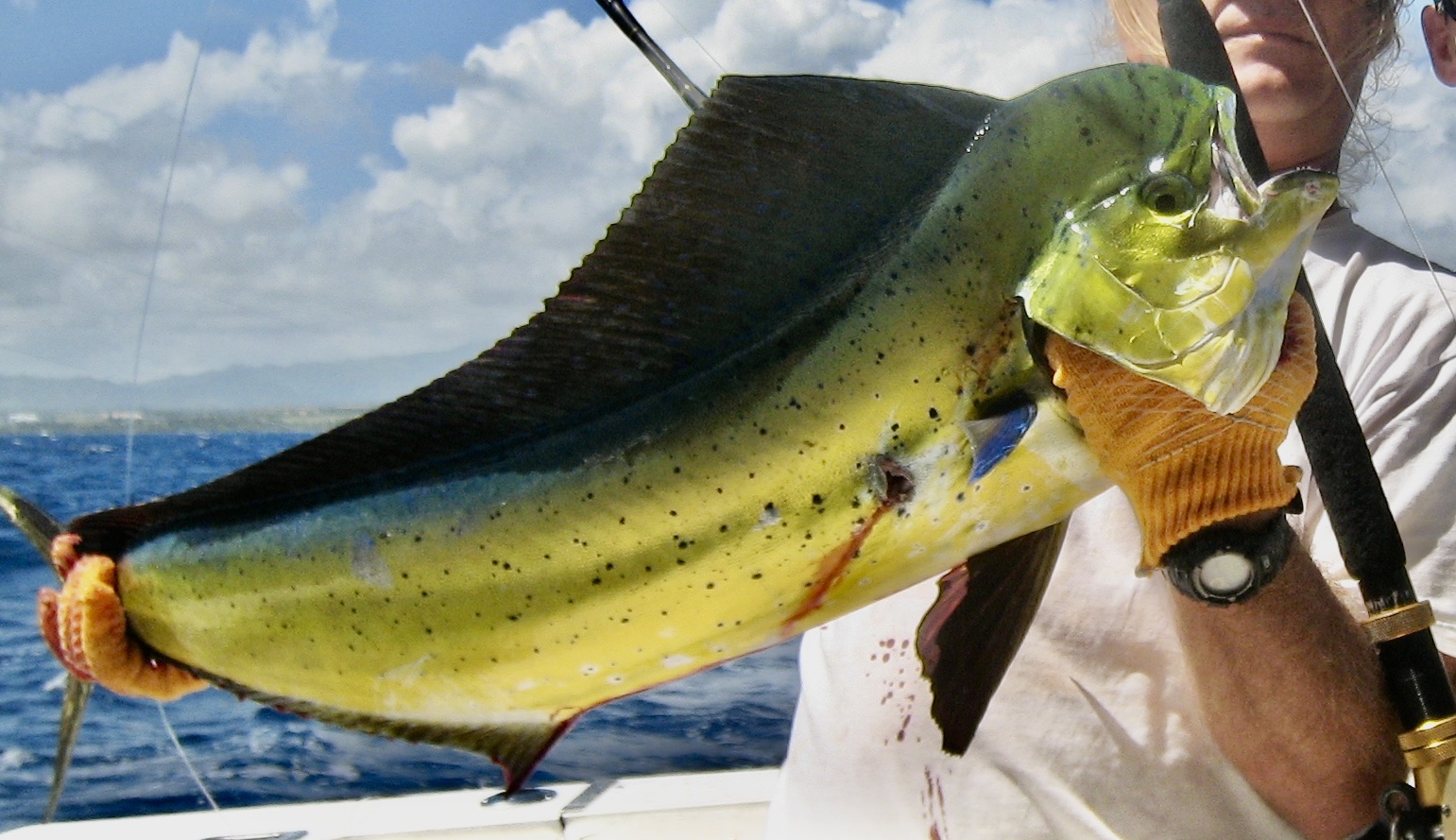I am stepping onto the boat unaware that I’d end up with two options on this deep-sea fishing trip: using a rod or a bucket. Unbeknownst to me, the seas are rougher off the coast of Kauai than off any other Hawaiian island. And as I’d find out once more, good sea legs plus a well-moored stomach are as necessary as the best fishing gear.
To make matters worse, our five-year-old grandson is convinced there is a “monster down there.” Yet all Captain Tim said is, “the head is down there” as he pointed to the lower deck and the stairs to the toilet.
Setting Sails for Deep Sea Fishing
In the Hawaiian archipelago, Kauai Island is the oldest and northernmost. Mark Twain even compared Waimea Canyon (on the western side) to the iconic Grand Canyon, so let’s imagine similar peaks and valleys underwater just off the coast. For this reason, fifteen minutes offshore is already deep sea fishing territory, and the deeper it is, the bigger the fish.
We had share-chartered Kai Bear Sportfishing Grander, a 42’ Bertram Convertible sport fishing boat, at a cost of $800 for a four-hour trip: a powerful and safe 30-ton boat consumes a lot of gas! When the other party didn’t show up, so did the sharing of the cost, something to remember at booking time. We could have canceled too but gave Captain Tim our ok instead. After the usual safety instructions, we sailed off Nawiliwili Harbor on the southeastern side of Kauai (a ten-minute drive from the Lihue airport).
Something About Deep Sea Fishing
If you have wanted to catch game fish ever since you read The Old Man and the Sea (although Hemingway’s character fought a marlin), this is it. Deep sea fishing is also called big-game fishing, offshore sport fishing, offshore game fishing, and blue-water fishing. Whatever the name, game fishing means fighting a big fish as a sport.
The sashimi or the poke on your plate (assuming you like raw fish) is only a tiny part of a 250-pound ahi tuna. Much smaller (up to 25 pounds) and in season in February (when we went), is mahi-mahi, and striped marlin. But if blue marlin is on your mind, it’s best to plan a whole day at sea for a better chance to fight the prized 900-pounder (the peak season is July/August).
Fighting Game Fish and Seasickness
The coastline unfolds alongside the ultramarine blue of the ocean and the vibrant green of the lush vegetation that crawls on the rugged coast. Less than ten minutes out, I am paying less attention to the coast and more to the rocking of the boat. I am not the only one: my grandson feels so queasy he forgets about the “head down there” and must lie down. As I lower myself next to him, seasickness gets to me too, a debilitating condition caused by our confused brain: the eyes don’t see the motion that our inner ear signals to the brain. If prone to seasickness, it’s best to look out and forward.
Ready, Set, Strike
Deckhand Sean describes the equipment specific to deep-sea fishing and prepares the lines. Twenty minutes have gone by when…
Strike! One of six lines bends and wiggles as Deckhand Sean hollers, “Get in the chair!” (The one centered at the stern). He swiftly places the butt of the rod into a gimbaled mount (a sort of rotating support) as Jim begins to reel in. A tuna fish emerges but doesn’t hook properly and gets loose. We bid the nibbler goodbye, hoping a glutton will save the day. I ask for the bucket, just in case.
Strike again! It’s my son’s turn. The rod bends as if it’s about to snap, but holds as he reels in, inches at a time. Then it all goes fast. Deckhand Sean leans over the water to grab the line as Captain Tim (who has momentarily left the flying bridge) hustles over, holding a gaff (a pole with a sharp hook). He stabs, then hauls a feisty fish that shimmers in mid-air and violently lands on the deck. The distinctive mahi-mahi bounces, pounding the wood deck with the troubling energy of survival.
We have a fish, a good size game fish! Sean hoists the flag to signal our specific catch to other boats, and Hawaii fish flag protocol. “Yes! We can go back now!” I say, still nauseated but not off the hook when I hear we chartered the boat for two more hours. Moments later, I hear an exhilarating “ono!” just as I vomit. Sean treats my bucket content to a burial at sea before hoisting an orange flag.
It has been less than three hours since we sailed off, but our now-private charter gives us the option to quit. What’s more, had we shared the boat, not everyone willing could have had a turn at reeling in a fish. As for the captain, an aborted trip isn’t a good deal since we boarded a working boat, that sells the surplus of the shared catch to restaurants.
Returning to port is a contrasting smooth ride for everyone on board. After mooring, Deckhand Sean takes the fish out of the ice box, washes it, and an impressive fish-filleting demonstration begins.
Later that day, our grandson tells his mother about our deep sea fishing trip in Hawaii, “The head stayed down there, Dad caught a fish, Papa lost his fish, and Nana threw up in the bucket.” Meanwhile, “Papa” ponders the most expensive fish we’ll ever eat. Never mind, deep sea fishing is off my bucket list!
Tomorrow, let’s settle for a calmer outing: seahorse farming
Notes
In retrospect, our grandson was likely too young for deep sea fishing, even though the mistaken “head down there” was an unsettling factor.
FYI, in Hawaii, a party that requests cutting the trip short can still claim its share of the catch.









